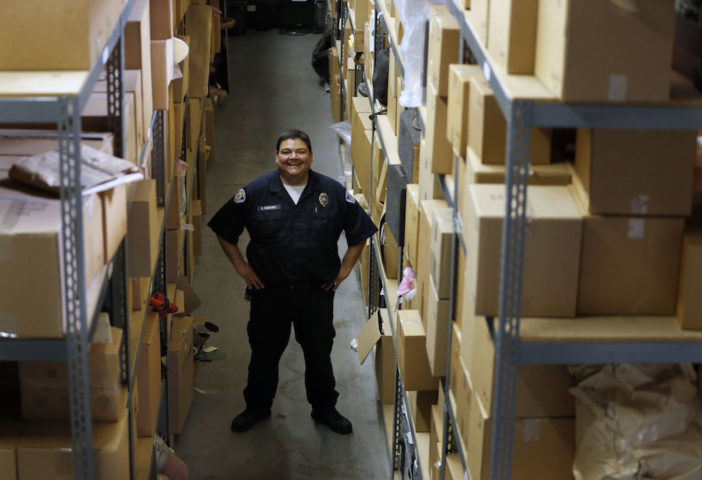Row after row of shelves, all of them packed tightly with cardboard boxes and miscellaneous items too large to fit in them, extend front to back and side in a Garden Grove warehouse the size of a high school gymnasium.
There are bicycles, skateboards, power tools, old stereo components, computer hard drives, drones (yes, drones), luggage and nitrous oxide (aka laughing gas) tanks.
There’s an antique sword, a surfboard and several seized video poker machines that were used in illegal gambling operations.
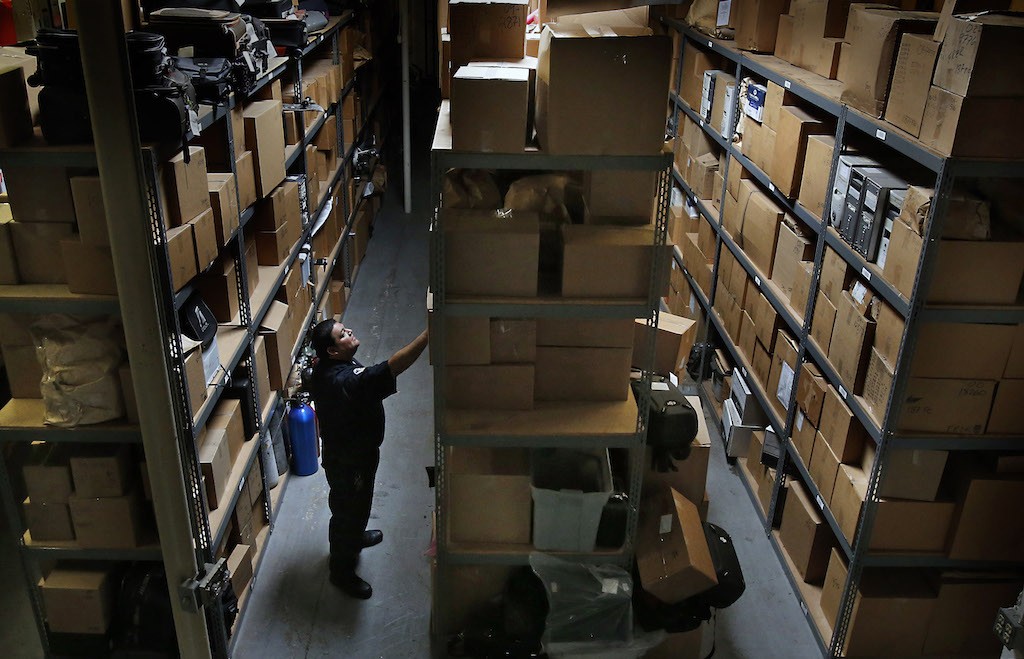
Eric Quintero, senior community services officer for the Garden Grove PD, searches through boxes at the department’s off-site evidence storage facility.
Photo by Christine Cotter
Welcome to the newest of three evidence/property storage facilities belonging to the Garden Grove Police Department.
These facilities house a combined 477,000 items linked to past and current cases.
Every stored object was either used to commit crimes, is seized property connected to a crime, or is lost property or evidence, such as DNA, that connects a suspect to a crime.
Narcotics and cash are locked in a safe inside one of the already secure warehouses.
One room holds shelves of handguns and racks of rifles.
Boxes and boxes of case files, some from crimes dating back to 1962, are also shelved.
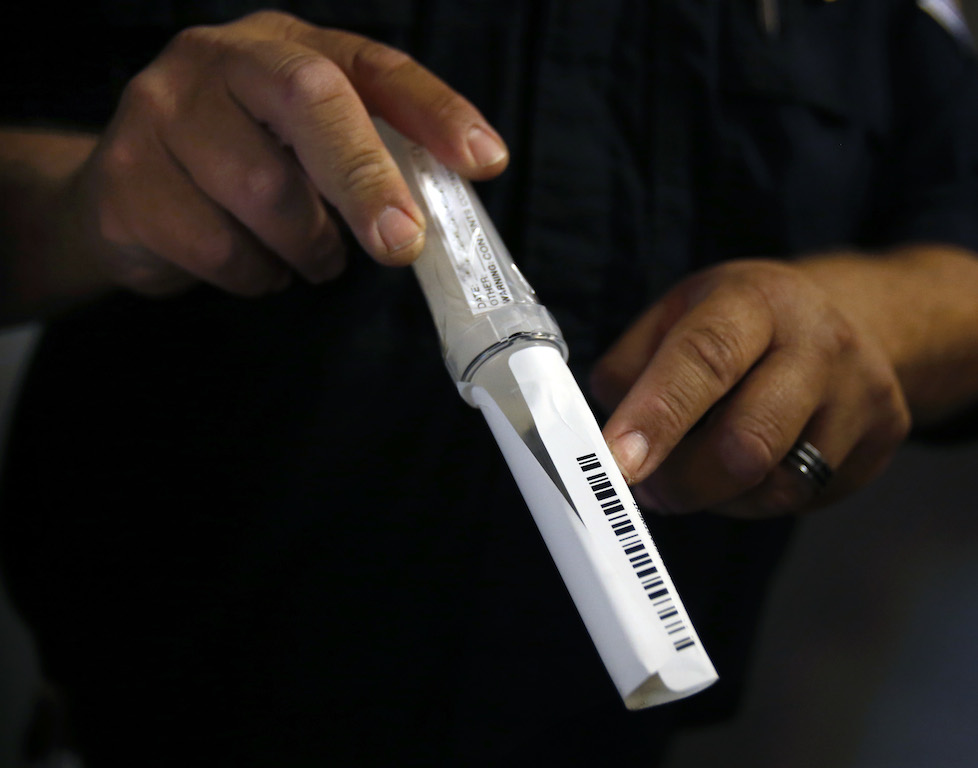
A meth pipe is among the items stored in the Garden Grove PD’s evidence locker.
Photo by Christine Cotter
Evidence connected to identify theft comes in regularly.
So do crack pipes.
“It’s a lot of random stuff,” said GGPD Senior Community Services Officer Eric Quintero, who oversees the evidence storage houses along with Ron Doscher.
There have been as many as 100 pieces of evidence and seized property arriving in a single day, especially after a police raid at several locations, said Quintero, on the job for 15 years.
While the GGPD could stand to downsize the collection to make room for new items coming in every day, it’s not quite as easy as John Q. Citizen deciding to clean out his garage.
Virtually every single object and blood sample requires approval from a judge before it can be disposed of.
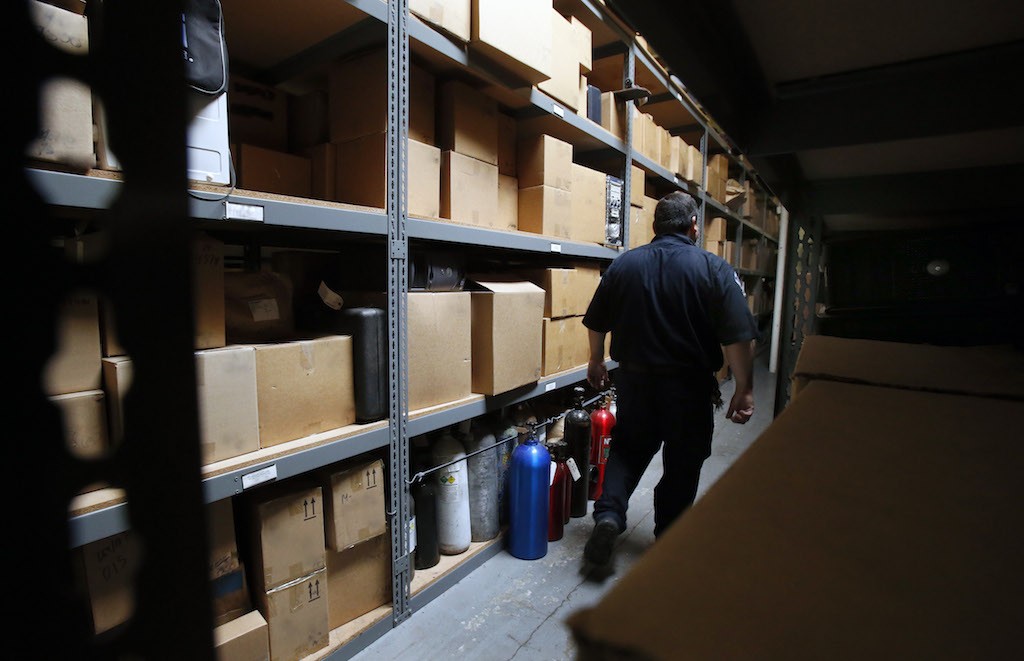
Eric Quintero, senior community services officer for the Garden Grove PD, walks past boxes of evidence at the department’s off-site evidence storage facility.
Photo by Christine Cotter
Evidence connected to homicides may never get destroyed.
“Violent crimes … we normally don’t get rid of (the evidence),” said Doscher, an 18-year veteran of the department.
In some instances, a judge, the prosecutor and the defense attorney may all be required to sign off before evidence can be returned or destroyed, Quintero said.
But once they get the nod, “We shred like crazy,” he said.
Preserving evidence that could be in storage for years is hugely important.
That’s where cold storage comes in.
Vials of blood are preserved in a refrigerator, set at 35 degrees, and DNA samples and blood-stained clothing are kept in the freezer, set at 0 degrees, Quintero said.

Guns held for evidence are stored in the Garden Grove PD’s evidence storage locker.
Photo by Christine Cotter
“We have to keep it from getting contaminated, especially for sex crimes,” Quintero said. “If they don’t make an arrest for a couple of years, we have to be able to produce a good sample. Before it was just old-fashioned finger prints, and now DNA has given us a whole other level.”
The most unusual piece of evidence Quintero’s ever seen in cold storage?
That would be a frozen goat leg, used by a disgruntled former employee of a supermarket to assault his manager.
“It’s a weapon, so we had to book it in our freezer,” Quintero said.
In cases involving stolen property, the department goes to great lengths to get the items back to their owners.
But it’s not always that simple, Quintero said.
Some years back, GGPD arrested thieves who’d been stealing luggage from travelers staying in hotels near Disneyland.
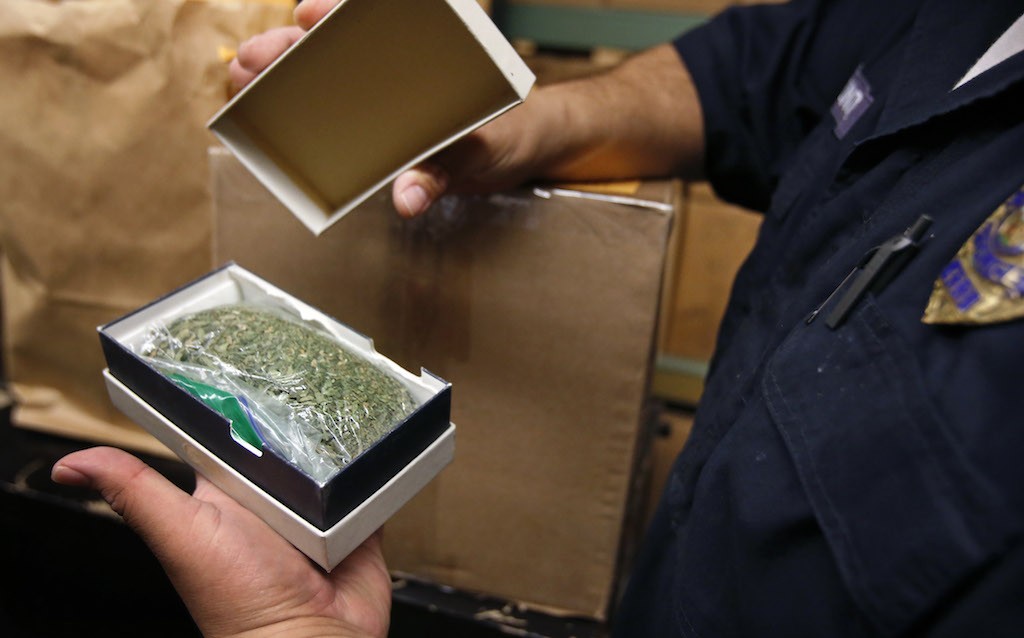
A confiscated bag of marijuana was discovered hidden in a Samsung Galaxy Note cell phone box. .
Photo by Christine Cotter
Many of those suitcases, still packed with clothing, sit in the evidence warehouse because their owners have either long written them off or live in another state or country.
Once the department is 100-percent certain that the owners of stolen or lost items can’t be found, and after a judge signs off, the stuff can finally be removed from storage.
GGPD partners with PropertyRoom.com, an online auction site similar to eBay, in which the public can bid on merchandise previously seized, stolen or lost.
GGPD gets a 40 percent cut of the sale price, Quintero said.
Unclaimed clothing sometimes gets donated to charities.
Doscher said overseeing evidence storage is more time consuming than it is difficult.
But it definitely involves a high level of responsibility.

A trash barrel full of skateboards at the Garden Grove PD’s evidence storage locker.
Photo by Christine Cotter
“Chain of custody is very important,” Quintero said. “That’s the biggest responsibility we have.”
Evidence comes in and is logged and time stamped every time it is transferred from one place to another, from the officer on the street, to evidence storage, to court and back to evidence storage.
“If you get the chain broken it can plant the seed (of doubt) in a jury’s mind,” Quintero said. “It’s basically the cradle to the grave.”
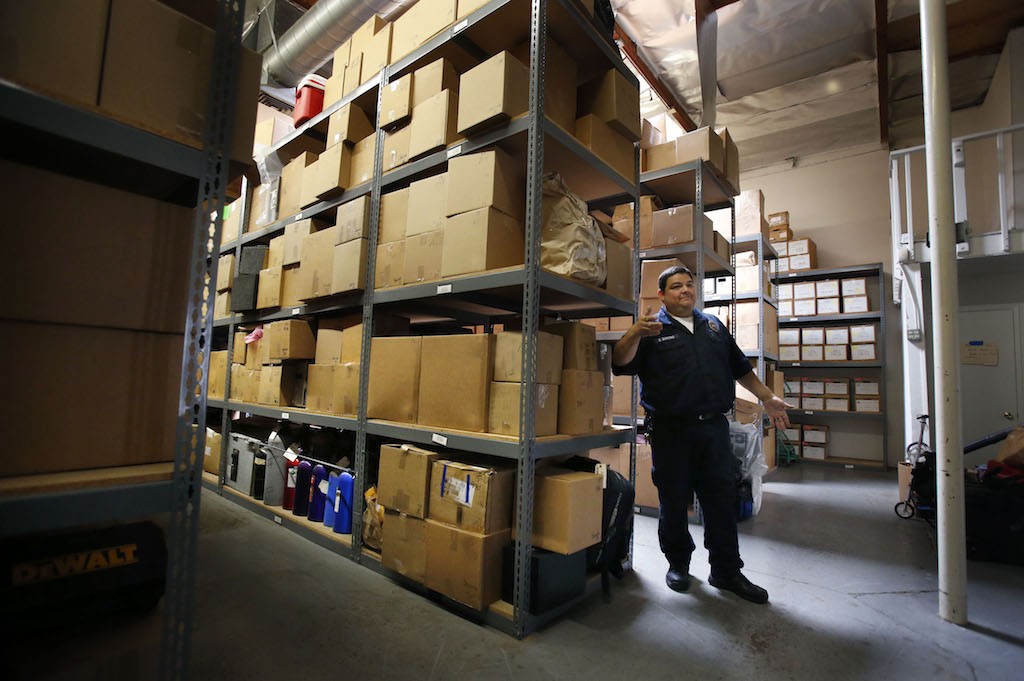
Stacks of boxes filled with evidence tower over the Garden Grove PD’s Eric Quintero in the department’s evidence locker.
Photo by Christine Cotter
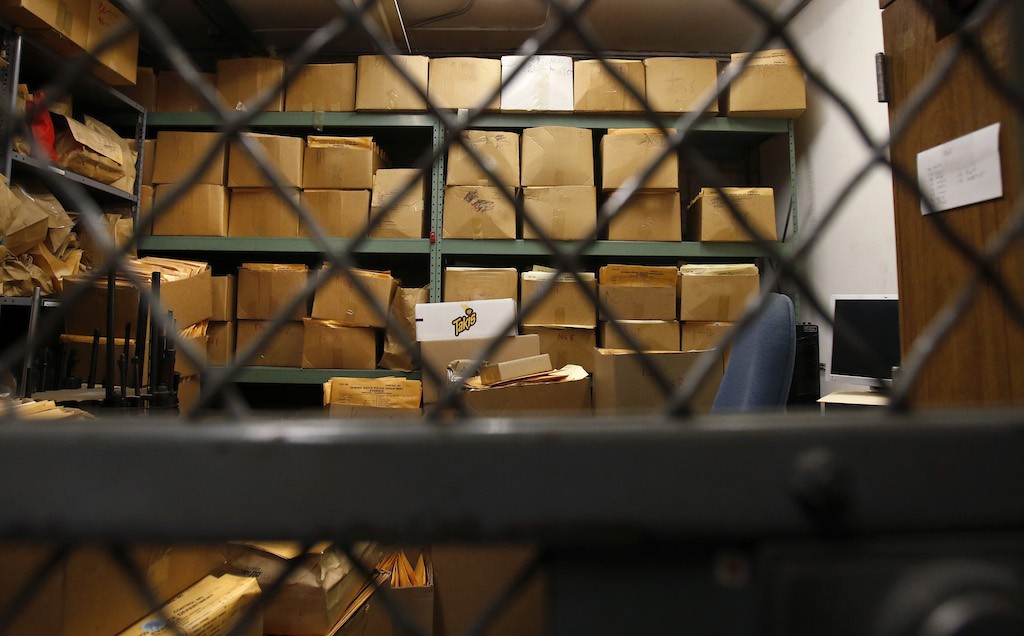
Stacks of boxes filled with evidence are securely locked up in the Garden Grove PD’s evidence locker at the police station.
Photo by Christine Cotter
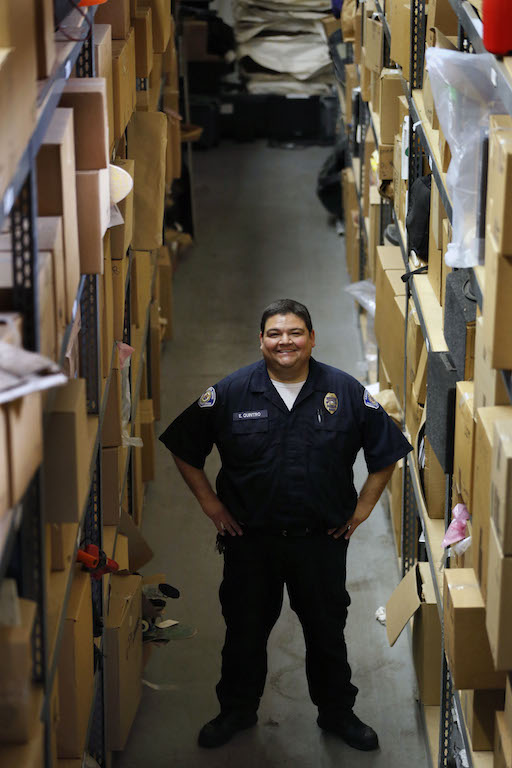
Eric Quintero, senior community services officer in Property and Evidence, works at the Garden Grove PD’s massive evidence storage facility.
Photo by Christine Cotter
 Behind the Badge
Behind the Badge
